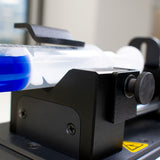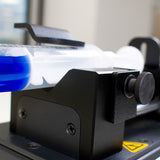The Role of Syringe Pumps in Scientific Research

Precision plays an important role in the modern research laboratory. Whether developing life-saving medications, engineering novel materials, or probing the mysteries of neuroscience, researchers are dependent on tools that ensure consistency, control, and accuracy. Among these instruments, syringe pumps are essential components of scientific research. The devices, designed to handle liquid, were specifically engineered to administer small volumes of fluids with unparalleled precision. This has made them the important aspect in accurate fluid delivery in a wide array of discipline.
On This Page
What is a syringe pump?
A syringe pump is a programmable instrument designed to deliver or withdraw fluids at highly controlled rates. Despite their relatively simple appearance, syringe pumps offer advanced programmability, allowing for a wide range of operations including stepped infusions, ramped flow rates, periodic dispensing, and triggered delivery. The syringe acts as both the fluid reservoir and delivery mechanism. The pump's motor controls the movement of the plunger, which ensures a pulse-free, accurate flow that is difficult to achieve manually.
In addition to dispensing, syringe pumps feature a withdrawal function, enabling fluid sampling or reverse operations. Their adaptability makes them suitable for both batch and continuous processes, a vital requirement in many advanced laboratory setups.
Why are syringe pumps important in research?
High precision and accuracy at both high and low flow rates
Compatibility with a broad range of chemicals and solvents
Pulse-free flow delivery
Flexibility in programming for complex workflows
Low maintenance and calibration-free operation
Experiments require high precision and reproducibility. Syringe pumps offer the type of control needed by researchers for handling small volumes, especially at the micro- or nano-scale. Their ability to automate and precisely regulate fluid flow minimizes human error and enhances experimental repeatability.
While the benefits of syringe pumps are many, it is important to consider their limitations as well. Single-syringe pumps, for example, are constrained by the volume of the syringe and may not be ideal for long-duration flow processes. They also struggle with slurries or solid-laden fluids. For such cases, dual-syringe pumps - with reciprocating mechanisms - enable continuous flow at higher pressures, often up to 20 bar, making them suitable for demanding applications like flow chemistry.
Applications across scientific disciplines
Chemistry
Syringe pumps are essential in chemical synthesis, specifically in flow chemistry, where they provide precise control over reaction conditions. Thanks to syringe pumps, researchers are able to control the addition, mixing and stoichiometric balance, ensuring consistent and safe chemical reactions. Dual-syringe pumps, when used with check valves and reagent reservoirs, support continuous operations.
Neuroscience
The use of syringe pumps in neuroscience includes accurate administration of micro doses of drugs to specific regions of the brain. This is an important aspect of maintaining a precise dosing regimens as well as collecting pharmacokinetic data.
Biomedical engineering and cell biology
Syringe pumps are in integral part of biomedical laboratories, as they not only aid in delivering nutrients to growing cells but also enable the introduction of reagents for tissue engineering. Their precise flow control supports cell viability and experimental consistency.
Protein purification and chromatography
Syringe pumps in chromatography systems enable the control of separation of proteins for biochemical studies. Their stable flow ensures optimal peak resolution and efficient separation.
Environmental and material sciences
The syringe pumps in environmental analysis are used in sample preparation and delivery for the assessment of air and water quality. In materials science, syringe pumps are used in applications where accuracy is crucial to reproducibility, such as the creation of nanomaterials, thin films, and coating.
Mass spectrometry and instrumental analytics
Techniques like electrospray ionization (ESI), high-performance liquid chromatography (HPLC), and LC-MS rely on pulse-free, accurate fluid delivery, making syringe pumps the perfect tool for them. These systems demand stable and consistent flow rates for reliable signal generation and data integrity.
Syringe Pump

Learn More
 Microfluidic Cell Sorting using a Syringe Pump
Microfluidic Cell Sorting using a Syringe Pump
Microfluidic cell sorting is bringing a change to cell sorting in research laboratories. Unlike traditional techniques, that are often expensive, microfluidic devices are compact and efficient. Among being more cost-effective, they offer precise control over how the cells are sorted. The effectiveness of a microfluidic cell sorter largely depends on key characteristics, including throughput, ease of use, and whether the chip has sensors and pumps built in. The most common actuation product used for microfluidic cell sorting is the syringe pump.
Read more... Syringe Pumps in Cell Analysis Techniques
Syringe Pumps in Cell Analysis Techniques
A syringe pump is used in controlled delivery of liquids because it offers a high level of accuracy and reliability. Cell analysis require precise flow control, which makes syringe pumps highly suitable thanks to their ability to deliver micro- and nanolitre volumes. Whether syringe pumps are implemented in microfluidics or single-cell analysis, they ensure consistency across different replicates of an experiment and preserve sample integrity.
Read more...